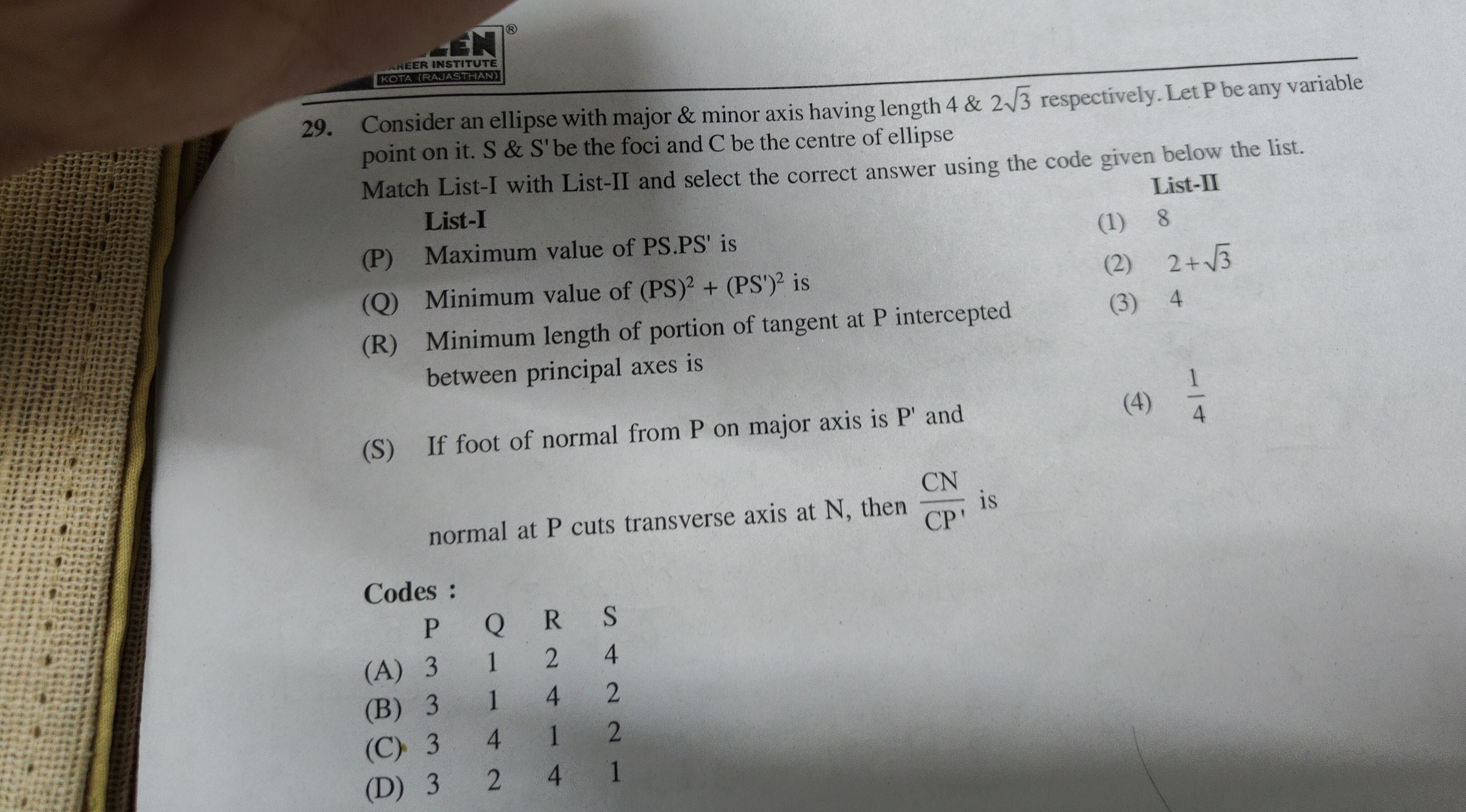Question
Question: Consider an ellipse with major & minor axis having length 4 & $2\sqrt{3}$ respectively. Let P be any...
Consider an ellipse with major & minor axis having length 4 & 23 respectively. Let P be any variable point on it. S & S'be the foci and C be the centre of ellipse Match List-I with List-II and select the correct answer using the code given below the list. List-I List-II (P) Maximum value of PS.PS' is (Q) Minimum value of (PS)2+(PS′)2 is (R) Minimum length of portion of tangent at P intercepted between principal axes is (S) If foot of normal from P on major axis is P' and normal at P cuts transverse axis at N, then CP′CN is

3
1
2
4
8
2+3
4
2+3
1/4
P-3, Q-1, R-2, S-4
Solution
The ellipse has a major axis of length 2a=4, so a=2. The minor axis has length 2b=23, so b=3. The eccentricity e is given by b2=a2(1−e2). (3)2=22(1−e2)⟹3=4(1−e2)⟹1−e2=43⟹e2=41⟹e=21. The foci are S=(ae,0) and S′=(−ae,0). ae=2×21=1. So S=(1,0) and S′=(−1,0). The center C is (0,0). Let P(x,y) be any point on the ellipse. The distances from P to the foci are PS=a+ex and PS′=a−ex. For P(acosθ,bsinθ)=(2cosθ,3sinθ), x=2cosθ. PS=2+21(2cosθ)=2+cosθ. PS′=2−21(2cosθ)=2−cosθ.
(P) Maximum value of PS.PS' PS⋅PS′=(2+cosθ)(2−cosθ)=4−cos2θ. This product is maximum when cos2θ is minimum, i.e., cos2θ=0. Maximum value =4−0=4. This matches with option (3).
(Q) Minimum value of (PS)2+(PS′)2 (PS)2+(PS′)2=(2+cosθ)2+(2−cosθ)2 =(4+4cosθ+cos2θ)+(4−4cosθ+cos2θ) =8+2cos2θ. This sum is minimum when cos2θ is minimum, i.e., cos2θ=0. Minimum value =8+2(0)=8. This matches with option (1).
(R) Minimum length of portion of tangent at P intercepted between principal axes The equation of the tangent at P(x0,y0) is a2xx0+b2yy0=1. For P(2cosθ,3sinθ), the tangent is 4x(2cosθ)+3y(3sinθ)=1, which simplifies to 2xcosθ+3ysinθ=1. The x-intercept (when y=0) is A=cosθ2. The y-intercept (when x=0) is B=sinθ3. The length L of the intercepted portion is A2+B2=cos2θ4+sin2θ3. To minimize L, we minimize L2=cos2θ4+sin2θ3. Let u=cos2θ. L2=u4+1−u3. The minimum value of L2 is (4+3)2=(2+3)2 when u4=1−u3, which yields u=74. The minimum length L=(2+3)2=2+3. This matches with option (2).
(S) If foot of normal from P on major axis is P' and normal at P cuts transverse axis at N, then CP′CN is Let P(x0,y0)=(acosθ,bsinθ). The foot of the perpendicular from P to the major axis is P′=(x0,0). So, P′=(2cosθ,0). CP′=∣2cosθ∣. The equation of the normal at P(x0,y0) is cosθax−sinθby=a2−b2. The normal cuts the transverse axis (x-axis) at N. Setting y=0: cosθaxN=a2−b2⟹xN=a(a2−b2)cosθ. a=2,b=3,a2=4,b2=3. xN=2(4−3)cosθ=21cosθ. So N=(21cosθ,0). CN=∣21cosθ∣. Then CP′CN=∣2cosθ∣∣21cosθ∣=21/2=41. This matches with option (4).
The correct matches are P-3, Q-1, R-2, S-4.
